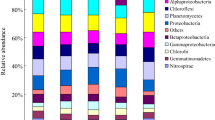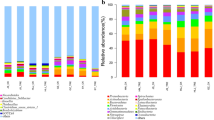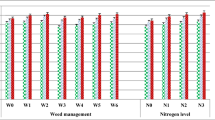Abstract
Purpose
Soil microbes play important roles in plant nutrition and soil conservation, and the diversity and population of soil microbe are influenced by abiotic and biotic factors associated with different soil managements. However, the information concerning soil microbe diversity and population structure and its relation with soil fertility and enzyme activities are scarce in crop rotation under different soil management system.
Materials and methods
This paper reports the effects of three weeding managements (herbicide (2-chloro-N-(ethoxymethyl)-N-(2-ethyl-6-methylphenyl) acetomide, C14H20ClNO2), manual weeding, and no weeding (CK)), on soil microbial diversity, population structure, and its relationship with soil active organic matter (AOM) and pH, and the activity of soil enzymes like sucrase, catalase, and urease activities from long-term test area in red soil upland field in southeast China, which was set up since 2006. Soil samples at 0–20-cm depths were collected before (8 years) and after (8 + 1 years) weeding management in April 2014.
Results and discussion
Soil enzymes (sucrase, catalase, and urease activity) and soil microbial populations had no significant difference (P > 0.05) under the three weeding treatments. Based on richness of microbial population up to 0.10%, the phyla Proteobacteria and Actinobacteria highly dominated the three soil treatments, averagely accounting for 21.76 and 21.44%. Chloroflexi was the next phylum, about accounting for 6.84%. Firmicutes, Verrucomicrobia, and Planctomycetes phylum accounted for 4.98, 4.78, and 4.23%, respectively. The percentage of Gemmatimonadetes was 2.76%, and that of Bacteroidetes was about 1.45%. Armatimonade and Nitrospira were the lowest, with 0.69 and 0.26%, respectively. Among the 20 phyla, only 5 had significant correlation with some of the soil properties. Twenty-one in 46 classes had significant correlation with some of the soil properties. Armatimonadetes and Fusobacteria had positive correlation with moisture. Acidobacteria_Gp3, Deltaproteobacteria, Chthonomonadetes, Armatimonadetes_gp4, and Euryarchaeota also were positively correlated with moisture. Negative correlation between Armatimonadetes, Chloroflexi, Chthonomonadetes, and Armatimonadetes_gp5 and AOM exists, and Armatimonadetes, Chthonomonadetes, Clostridia, Armatimonadetes, and pH were negatively correlated. Fusobacteria was positively correlated with catalase. Acidobacteria_Gp10 and Armatimonadia were positively correlated with catalase. Chthonomonadetes, Clostridia, and Armatimonadetes_gp5 were correlated with urease. Gammaproteobacteria and Flavobacteria were correlated with sucrase.
Conclusions
For long-term herbicide experiment conducted on the Dongxiang upland site, no significant effect of herbicide on soil microbial community composition and enzyme activities was found. Further work is needed to relate microbial community structure and function in different herbicide systems or season sampling, even to detect herbicide effect on community structure during the growing season.



Similar content being viewed by others
References
Ajwaa HA, Dell CJ, Rice CW (1999) Changes in enzyme activities and microbial biomass of tallgrass rairie soil as related to burning and nitrogen fertilization. Soil Biol Biochem 31:769–777
Bai Z, Xu HJ, He HB et al (2013) Alterations of microbial populations and composition in the rhizosphere and bulk soil as affected by residual acetochlor. Environ Sci Pollut Res 20(1):369–379
Bainard LD, Koch AM, Gordon AM et al (2013) Growth response of crops to soil microbial communities from convertional monocropping and tree-based intercropping systems. Plant Soil 363:345–356
Balota EL, Kanashiro M, Filho AC et al (2004) Soil enzyme activities under long-term tillage and crop rotation systems in subtropical ago-ecosystems. Braz J Microbiol 35:300–306
Barriuso J, Marín S, Mellado RP et al (2010) Effect of the herbicide glyphosate on glyphosate-tolerant maize rhizobacterial communities: a comparison with pre-emergency applied herbicide consisting of a combination of acetochlor and terbuthylazine. Environ Microbiol 12:1021–1030
Bell T, Newman JA, Silverman BW et al (2005) The contribution of species richness and composition to bacterial services. Nature 436:1157–1160
Brooks DD, Twieg BD, Grayston SJ et al (2013) Physical extent, frequency, and intensity of phosphatase activity varies on soil profiles across a Douglas-fir chronosequence. Soil Biol Biochem 64:1–8
Burns RG (1978) Soil enzymes. New York Academic Press, pp:188–189
Cai XY, Sheng GY, Liu WP (2007) Degradation and detoxification of acetochlor in soils treated by organic and thiosulfate amendments. Chemosphere 66:286–292
Caporaso JG, Kuczynski J, Stombaugh J, Bittinger K, Bushman FD, Costello EK, Fierer N, Pefia AG, Goodrich JK, Gordon JI, Huttley GA, Kelley ST, Knights D, Koenig JE, Ley RE, Lozupone CA, McDonald D, Muegge BD, Pirrung M, Reeder J, Sevinsky RS, Turnbaugh PJ et al (2010) QIIME allows analysis of high-throughput community sequencing data. Nature Meth 7(5):335–336
Caporaso JG, Lauber CL, Walters WA et al (2012) Ultra-high-throughput microbial community analysis on the Illumina HiSeq and MiSeq platforms. Int Soc Microb Ecol 6:1621–1624
Congreves KA, Hayes A, Verhallen EA et al (2015) Long-term impact of tillage and crop rotation on soil health at four temperate agroecosystems. Soil Till Res 152:17–28
Cui HP, Zhao GQ, Liu H (2014) Effects of herbicide on the activities of urease and alkaline phosphatase in oat field. Chinese J Glassland 36(1):37–43
Dictor MC, Baran N, Gautier A et al (2008) Acetochlor mineralization and fate of its two major metabolites in two soils under laboratory conditions. Chemosphere 71:663–670
Dong LG, Yuan HM, Li SB et al (2010) Influence on soil microbial community functional diversity for maize no-tillage with straw mulch. Ecol Environ Sci 19(2):444–446
Drinkwater LE, Snapp SS (2007) Nutrients in agroecosystems: rethinking the management paradigm. Adv Agron 92:163–186
Edgar RC, Haas BJ, Clemente JC et al (2011) UCHIME improves sensitivity and speed of chimera detection. Bioinform 27(16):2194–2200
Elliot ET, Coleman DC (1988) Let the soil work for us. Ecol Bull 39:23–32
Ercolini D (2013) High-throughput sequencing and metagenomics: moving forward in the culture-independent analysis of food microbial ecology. Appl Environ Microbiol 79:3148–3155
Foley ME, Sigler V, Gruden CL (2008) A multiphasic characterization of the impact of the herbicide acetochlor on freshwater bacterial communities. Int Soc Microb Ecol 2:56–66
Giri B, Giang PH, Kumari R et al (2005) Microbial diversity in soils. In: Buscot F, Varma A (eds) Microorganisms in soils: roles in genesis and functions, soil biology, 3. Springer, Berlin, pp 19–55
Lu RK (2000) The analysis method of soil agricultural chemistry. Chinese Agricultural Sciences and Technology Press (in Chinese)
Margesin R, Walder G, Schinner F (2000) The impact of hydrocarbon remediation (diesel oil and polycyclic aromatic hydrocarbons) on enzyme activities and microbial properties of soil. Acta Biotechnol 20:313–333
Mijangos I, Becerril JM, Albizu I et al (2009) Effects of glyphosate on rhizosphere soil microbial communities under two different plant compositions by cultivation-dependent and -independent methodologies. Soil Biol Biochem 41:505–513
Oliveros JC (2007) VENNY. An interactive tool for comparing lists with Venn Diagrams. http://bioinfogp.cnb.csic.es/tools/venny/index.html
Peng X, Liu CE, Duan CQ et al (2009) Effect of herbicides on urease activity in soil. Mod Agrochem 86:31–36
Petersen SO, Frohne PS, Kennedy AC (2002) Dynamics of a soil microbial community under spring wheat. Soil Sci Soc Am J 66:826–833
Rillig MC, Mummey DL (2006) Mycorrhizas and soil structure. New Phytol 171:41–53
Smith SE, Read DJ (2008) Mycorrhizal symbiosis, 3rd edn. Academic, New York
Tebrügge F, Düring RA (1999) Reducing tillage intensity—a review of results from a long term study in Germany. Soil Till Res 53:15–28
Vasilakoglou IB, Eleftherohorinos IG, Dhima KB (2001) Activity, adsorption and mobility of three acetanilide and two new amide herbicides. Weed Res 41:535–546
Virág D, Naár Z, Kiss A (2007) Microbial toxicity of pesticide derivatives produced with UV-photodegradation. Bull Environ Contam T 79:356–359
Walters WA, Caporaso JG, Lauber CL et al (2011) PrimerProspector: de novo design and taxonomic analysis of barcoded polymerase chain reaction primers. Bioinform 27(8):1159–1161
Wang JH, Hu JL, Lin XG et al (2013) Effects of tillage management on microbiological characteristics related to transformation of carbon, nitrogen, and phosphorus in Luvo-aquic soil. Chinese J Appl Environ Biol 19(005):868–872
Wang P, Wang Y, Wu QS (2016) Effects of soil tillage and planting grass on arbuscular mycorrhizal fungal propagules and soil properties in citrus orchards in Southeast China. Soil Till Res 155:54–61
Xu J, Yang M, Dai J et al (2008) Degradation of acetochlor by four microbial communities. Bioresource Technol 99:7797–7802
Yao M, Rui J, Li JB et al (2014) Rate-specific responses of prokaryotic diversity and structure to nitrogen deposition in the Leymus Chinensis steppe. Soil Biol Biochem 79:81–90
Yu R, Xu MG, Wang BR (2005) Study on methods for determining labile organic matter of soils. Turang Feiliao 2:49–52
Zabaloy MC, Garland JL, Gómez MA (2008) An integrated approach to evaluate the impacts of the herbicides glyphosate, 2,4-D and metsulfuron-methyl on soil microbial communities in the Pampas region, Argentina. Appl Soil Ecol 40:1–12
Zhang W, Zhang GS, Liu GX et al (2012) Bacterial diversity and distribution in the southeast edge of the Tengger Desert and their correlation with soil enzyme activities. J Environ Sci 24(11):2004–2011
Zhang XL, Li X, Zhang CG et al (2011) Ecological risk of long-term chlorimuron-ethyl application to soil microbial community: an in situ inverstigation in a continuously cropped soybean field in Northeast China. Environ Sci Pollut Res 18:407–415
Zhang YF, Zhong WH, Li ZP et al (2006) Effects of long-term different fertilization on soil enzyme activity and microbial community functional diversity in paddy soil derived from quaternary red clay. J Ecol Rural Environ 22(4):39–44
Zheng H, Ye C (2003) Photodegradation of acetochlor in water and UV photoproducts identified by mass spectrometry. J Environ Sci China 15:783–790
Acknowledgements
This research was supported by the National Natural Science Foundation of China (31460147), Innovation fund of Jiangxi Academy of Agricultural Sciences (2012CJJ004), program for Cultivating Youths Scientist of Jiangxi Province (2014BCB23010), National Key Technology R&D Program of China (2011BAC13B03, 2011BAC13B04, 2012BAD15B03-02), and by the Opening Fund of Key Laboratory of Poyang Lake Wetland and Watershed Research (Jiangxi Normal University), Ministry of Education (China) (ZK2013001).
Author information
Authors and Affiliations
Corresponding authors
Additional information
Responsible editor: Qiaoyun Huang
Rights and permissions
About this article
Cite this article
Jiang, Y., Lin, D., Guan, X. et al. Effect of herbicide used with years (8 + 1) on soil enzymic activity and microbial population diversity. J Soils Sediments 17, 2490–2499 (2017). https://doi.org/10.1007/s11368-017-1672-x
Received:
Accepted:
Published:
Issue Date:
DOI: https://doi.org/10.1007/s11368-017-1672-x




